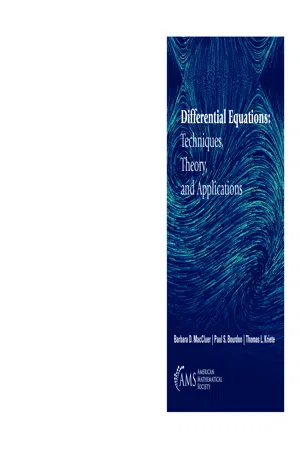
Differential Equations: Techniques, Theory, and Applications
- English
- PDF
- Available on iOS & Android
Differential Equations: Techniques, Theory, and Applications
About this book
Differential Equations: Techniques, Theory, and Applications is designed for a modern first course in differential equations either one or two semesters in length. The organization of the book interweaves the three components in the subtitle, with each building on and supporting the others. Techniques include not just computational methods for producing solutions to differential equations, but also qualitative methods for extracting conceptual information about differential equations and the systems modeled by them. Theory is developed as a means of organizing, understanding, and codifying general principles. Applications show the usefulness of the subject as a whole and heighten interest in both solution techniques and theory. Formal proofs are included in cases where they enhance core understanding; otherwise, they are replaced by informal justifications containing key ideas of a proof in a more conversational format. Applications are drawn from a wide variety of fields: those in physical science and engineering are prominent, of course, but models from biology, medicine, ecology, economics, and sports are also featured.The 1,400+ exercises are especially compelling. They range from routine calculations to large-scale projects. The more difficult problems, both theoretical and applied, are typically presented in manageable steps. The hundreds of meticulously detailed modeling problems were deliberately designed along pedagogical principles found especially effective in the MAA study Characteristics of Successful Calculus Programs, namely, that asking students to work problems that require them to grapple with concepts (or even proofs) and do modeling activities is key to successful student experiences and retention in STEM programs. The exposition itself is exceptionally readable, rigorous yet conversational. Students will find it inviting and approachable. The text supports many different styles of pedagogy from traditional lecture to a flipped classroom model. The availability of a computer algebra system is not assumed, but there are many opportunities to incorporate the use of one.
Frequently asked questions
- Essential is ideal for learners and professionals who enjoy exploring a wide range of subjects. Access the Essential Library with 800,000+ trusted titles and best-sellers across business, personal growth, and the humanities. Includes unlimited reading time and Standard Read Aloud voice.
- Complete: Perfect for advanced learners and researchers needing full, unrestricted access. Unlock 1.4M+ books across hundreds of subjects, including academic and specialized titles. The Complete Plan also includes advanced features like Premium Read Aloud and Research Assistant.
Please note we cannot support devices running on iOS 13 and Android 7 or earlier. Learn more about using the app.
Information
Table of contents
- Cover
- Title page
- Preface
- Chapter 1. Introduction
- Chapter 2. First-Order Equations
- Chapter 3. Numerical Methods
- Chapter 4. Higher-Order Linear Homogeneous Equations
- Chapter 5. Higher-Order Linear Nonhomogeneous Equations
- Chapter 6. Laplace Transforms
- Chapter 7. Power Series Solutions
- Chapter 8. Linear Systems I
- Chapter 9. Linear Systems II
- Chapter 10. Nonlinear Systems
- Chapter 11. Partial Differential Equations and Fourier Series
- Notes and Further Reading
- Selected Answers to Exercises
- Bibliography
- Index
- Back Cover